Written Test: Use Hygienic Practices for Food Safety - SITXFSA001
VerifiedAdded on 2023/01/04
|17
|5671
|1
Homework Assignment
AI Summary
This document presents a completed written test for the SITXFSA001 unit, focusing on the use of hygienic practices for food safety. The assessment covers various aspects, including food safety laws and regulations, definitions of contaminants, and the responsibilities of both employees and employers. It delves into personal hygiene practices, such as proper handwashing techniques, nail care, and appropriate attire, to prevent food contamination. The test also explores the causes and types of food contamination, including biological, physical, and chemical hazards, along with common sources of contamination in food service environments. Furthermore, the assessment examines handwashing procedures, required handwashing facilities, and instances that necessitate handwashing. The document also provides insights into the HACCP method and its role in controlling food safety. This resource offers a detailed overview of food safety principles and practices, making it a valuable tool for students studying in the field.
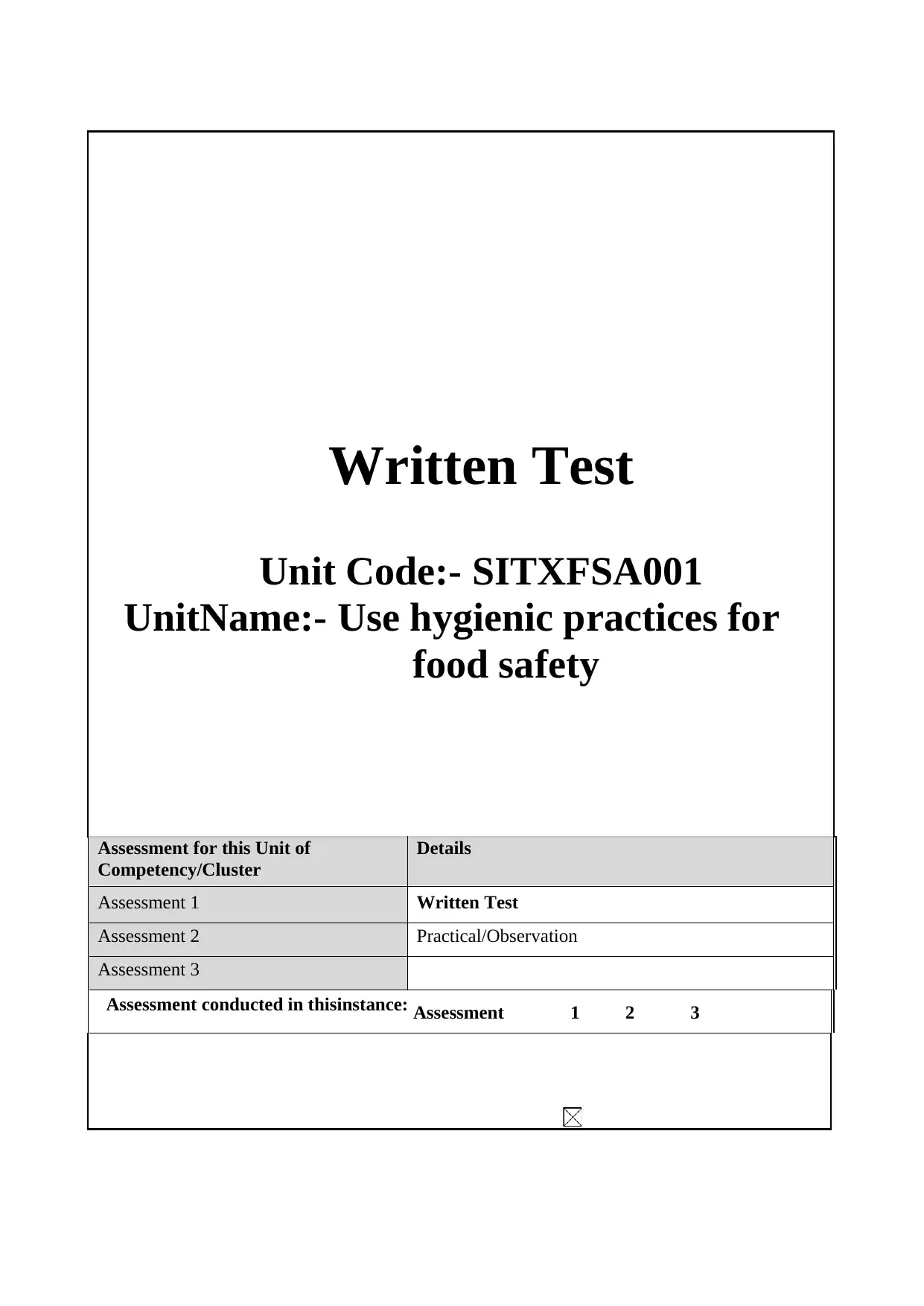
Written Test
Unit Code:- SITXFSA001
UnitName:- Use hygienic practices for
food safety
Assessment for this Unit of Details
Competency/Cluster
Assessment 1 Written Test
Assessment 2 Practical/Observation
Assessment 3
Assessment conducted in thisinstance: Assessment 1 2 3
Unit Code:- SITXFSA001
UnitName:- Use hygienic practices for
food safety
Assessment for this Unit of Details
Competency/Cluster
Assessment 1 Written Test
Assessment 2 Practical/Observation
Assessment 3
Assessment conducted in thisinstance: Assessment 1 2 3
Paraphrase This Document
Need a fresh take? Get an instant paraphrase of this document with our AI Paraphraser
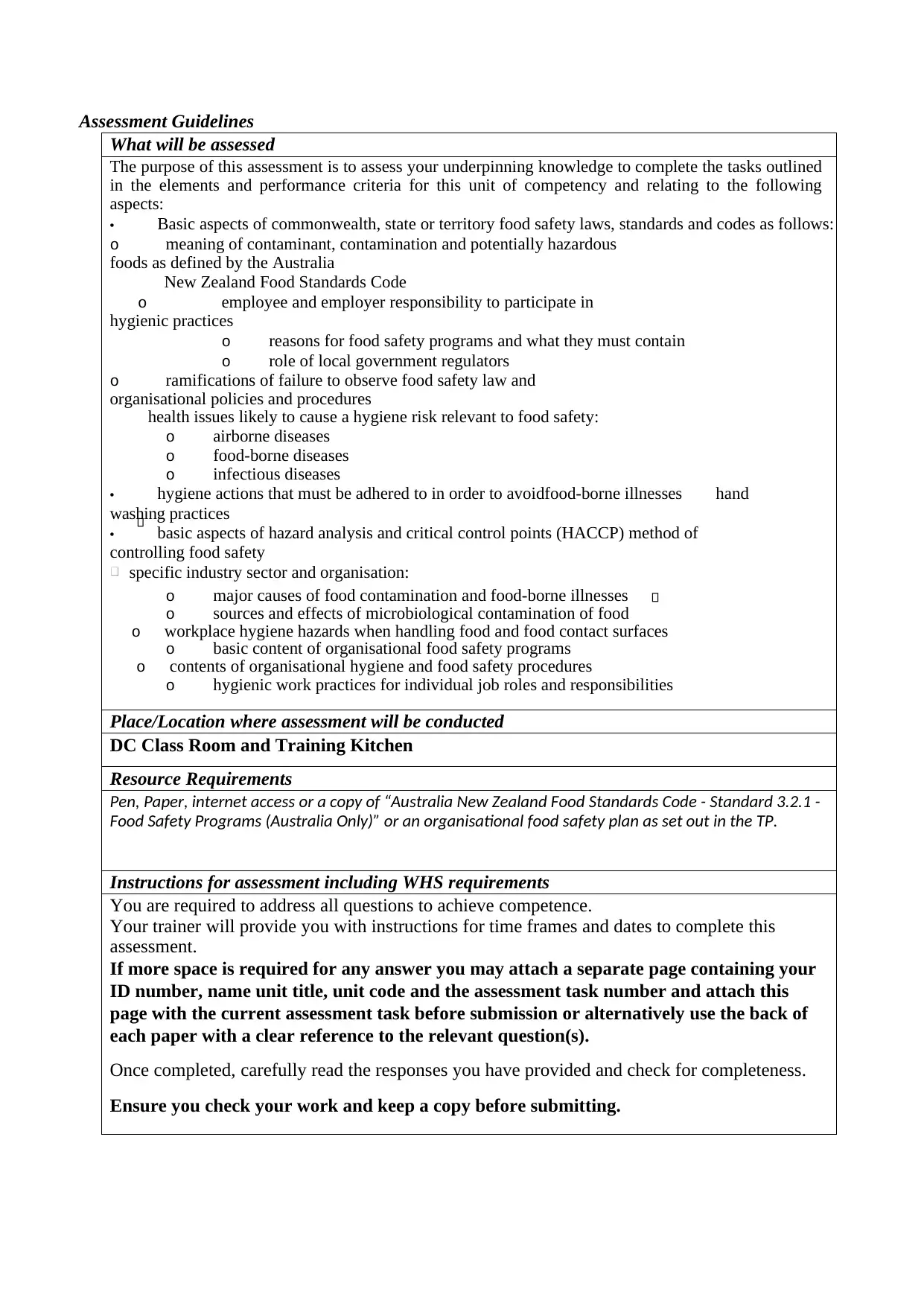
Assessment Guidelines
What will be assessed
The purpose of this assessment is to assess your underpinning knowledge to complete the tasks outlined
in the elements and performance criteria for this unit of competency and relating to the following
aspects:
• Basic aspects of commonwealth, state or territory food safety laws, standards and codes as follows:
o meaning of contaminant, contamination and potentially hazardous
foods as defined by the Australia
New Zealand Food Standards Code
o employee and employer responsibility to participate in
hygienic practices
o reasons for food safety programs and what they must contain
o role of local government regulators
o ramifications of failure to observe food safety law and
organisational policies and procedures
health issues likely to cause a hygiene risk relevant to food safety:
o airborne diseases
o food-borne diseases
o infectious diseases
• hygiene actions that must be adhered to in order to avoidfood-borne illnesses hand
washing practices
• basic aspects of hazard analysis and critical control points (HACCP) method of
controlling food safety
specific industry sector and organisation:
o major causes of food contamination and food-borne illnesses
o sources and effects of microbiological contamination of food
o workplace hygiene hazards when handling food and food contact surfaces
o basic content of organisational food safety programs
o contents of organisational hygiene and food safety procedures
o hygienic work practices for individual job roles and responsibilities
Place/Location where assessment will be conducted
DC Class Room and Training Kitchen
Resource Requirements
Pen, Paper, internet access or a copy of “Australia New Zealand Food Standards Code - Standard 3.2.1 -
Food Safety Programs (Australia Only)” or an organisational food safety plan as set out in the TP.
Instructions for assessment including WHS requirements
You are required to address all questions to achieve competence.
Your trainer will provide you with instructions for time frames and dates to complete this
assessment.
If more space is required for any answer you may attach a separate page containing your
ID number, name unit title, unit code and the assessment task number and attach this
page with the current assessment task before submission or alternatively use the back of
each paper with a clear reference to the relevant question(s).
Once completed, carefully read the responses you have provided and check for completeness.
Ensure you check your work and keep a copy before submitting.
What will be assessed
The purpose of this assessment is to assess your underpinning knowledge to complete the tasks outlined
in the elements and performance criteria for this unit of competency and relating to the following
aspects:
• Basic aspects of commonwealth, state or territory food safety laws, standards and codes as follows:
o meaning of contaminant, contamination and potentially hazardous
foods as defined by the Australia
New Zealand Food Standards Code
o employee and employer responsibility to participate in
hygienic practices
o reasons for food safety programs and what they must contain
o role of local government regulators
o ramifications of failure to observe food safety law and
organisational policies and procedures
health issues likely to cause a hygiene risk relevant to food safety:
o airborne diseases
o food-borne diseases
o infectious diseases
• hygiene actions that must be adhered to in order to avoidfood-borne illnesses hand
washing practices
• basic aspects of hazard analysis and critical control points (HACCP) method of
controlling food safety
specific industry sector and organisation:
o major causes of food contamination and food-borne illnesses
o sources and effects of microbiological contamination of food
o workplace hygiene hazards when handling food and food contact surfaces
o basic content of organisational food safety programs
o contents of organisational hygiene and food safety procedures
o hygienic work practices for individual job roles and responsibilities
Place/Location where assessment will be conducted
DC Class Room and Training Kitchen
Resource Requirements
Pen, Paper, internet access or a copy of “Australia New Zealand Food Standards Code - Standard 3.2.1 -
Food Safety Programs (Australia Only)” or an organisational food safety plan as set out in the TP.
Instructions for assessment including WHS requirements
You are required to address all questions to achieve competence.
Your trainer will provide you with instructions for time frames and dates to complete this
assessment.
If more space is required for any answer you may attach a separate page containing your
ID number, name unit title, unit code and the assessment task number and attach this
page with the current assessment task before submission or alternatively use the back of
each paper with a clear reference to the relevant question(s).
Once completed, carefully read the responses you have provided and check for completeness.
Ensure you check your work and keep a copy before submitting.
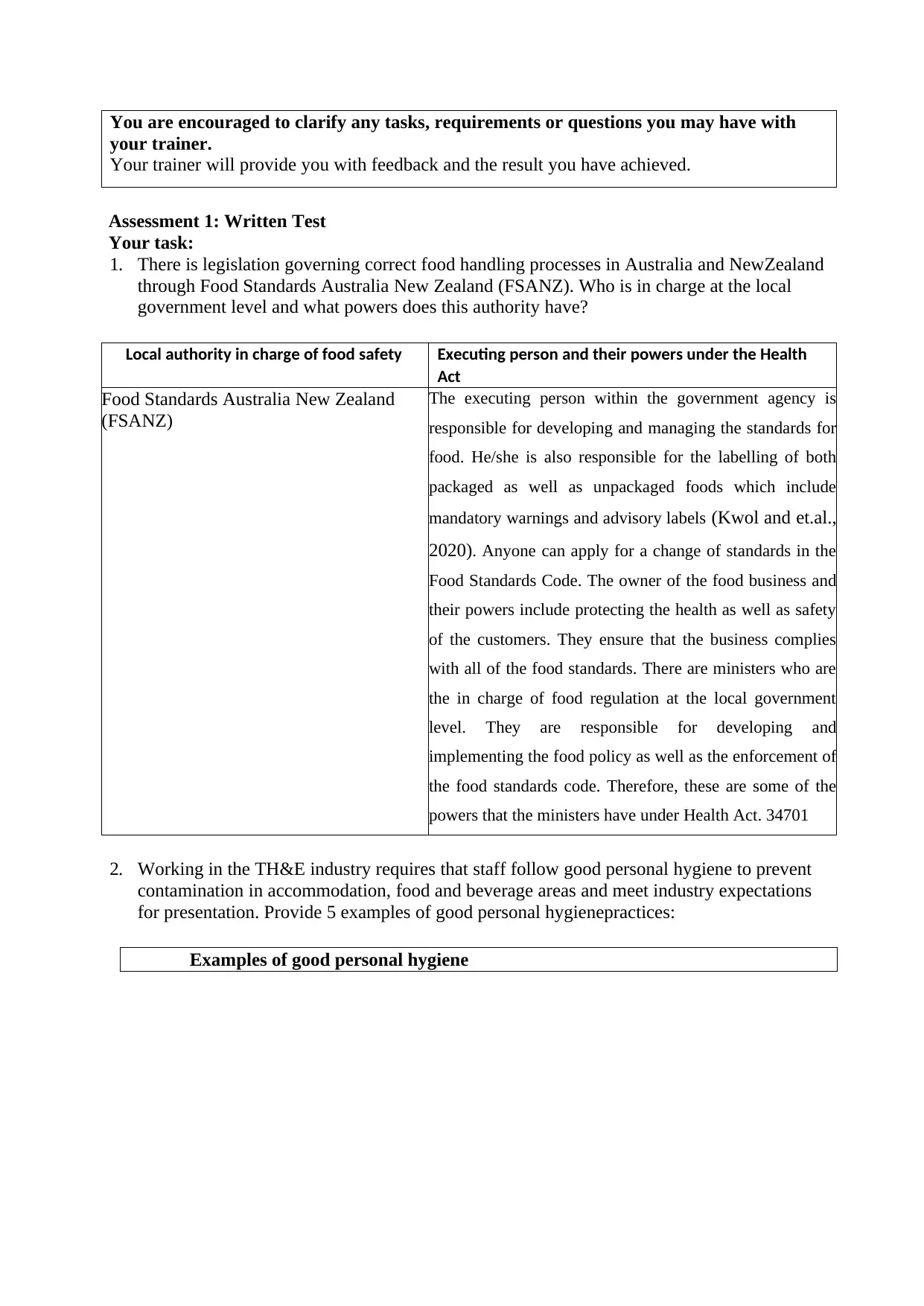
You are encouraged to clarify any tasks, requirements or questions you may have with
your trainer.
Your trainer will provide you with feedback and the result you have achieved.
Assessment 1: Written Test
Your task:
1. There is legislation governing correct food handling processes in Australia and NewZealand
through Food Standards Australia New Zealand (FSANZ). Who is in charge at the local
government level and what powers does this authority have?
Local authority in charge of food safety Executing person and their powers under the Health
Act
Food Standards Australia New Zealand
(FSANZ)
The executing person within the government agency is
responsible for developing and managing the standards for
food. He/she is also responsible for the labelling of both
packaged as well as unpackaged foods which include
mandatory warnings and advisory labels (Kwol and et.al.,
2020). Anyone can apply for a change of standards in the
Food Standards Code. The owner of the food business and
their powers include protecting the health as well as safety
of the customers. They ensure that the business complies
with all of the food standards. There are ministers who are
the in charge of food regulation at the local government
level. They are responsible for developing and
implementing the food policy as well as the enforcement of
the food standards code. Therefore, these are some of the
powers that the ministers have under Health Act. 34701
2. Working in the TH&E industry requires that staff follow good personal hygiene to prevent
contamination in accommodation, food and beverage areas and meet industry expectations
for presentation. Provide 5 examples of good personal hygienepractices:
Examples of good personal hygiene
your trainer.
Your trainer will provide you with feedback and the result you have achieved.
Assessment 1: Written Test
Your task:
1. There is legislation governing correct food handling processes in Australia and NewZealand
through Food Standards Australia New Zealand (FSANZ). Who is in charge at the local
government level and what powers does this authority have?
Local authority in charge of food safety Executing person and their powers under the Health
Act
Food Standards Australia New Zealand
(FSANZ)
The executing person within the government agency is
responsible for developing and managing the standards for
food. He/she is also responsible for the labelling of both
packaged as well as unpackaged foods which include
mandatory warnings and advisory labels (Kwol and et.al.,
2020). Anyone can apply for a change of standards in the
Food Standards Code. The owner of the food business and
their powers include protecting the health as well as safety
of the customers. They ensure that the business complies
with all of the food standards. There are ministers who are
the in charge of food regulation at the local government
level. They are responsible for developing and
implementing the food policy as well as the enforcement of
the food standards code. Therefore, these are some of the
powers that the ministers have under Health Act. 34701
2. Working in the TH&E industry requires that staff follow good personal hygiene to prevent
contamination in accommodation, food and beverage areas and meet industry expectations
for presentation. Provide 5 examples of good personal hygienepractices:
Examples of good personal hygiene
⊘ This is a preview!⊘
Do you want full access?
Subscribe today to unlock all pages.

Trusted by 1+ million students worldwide
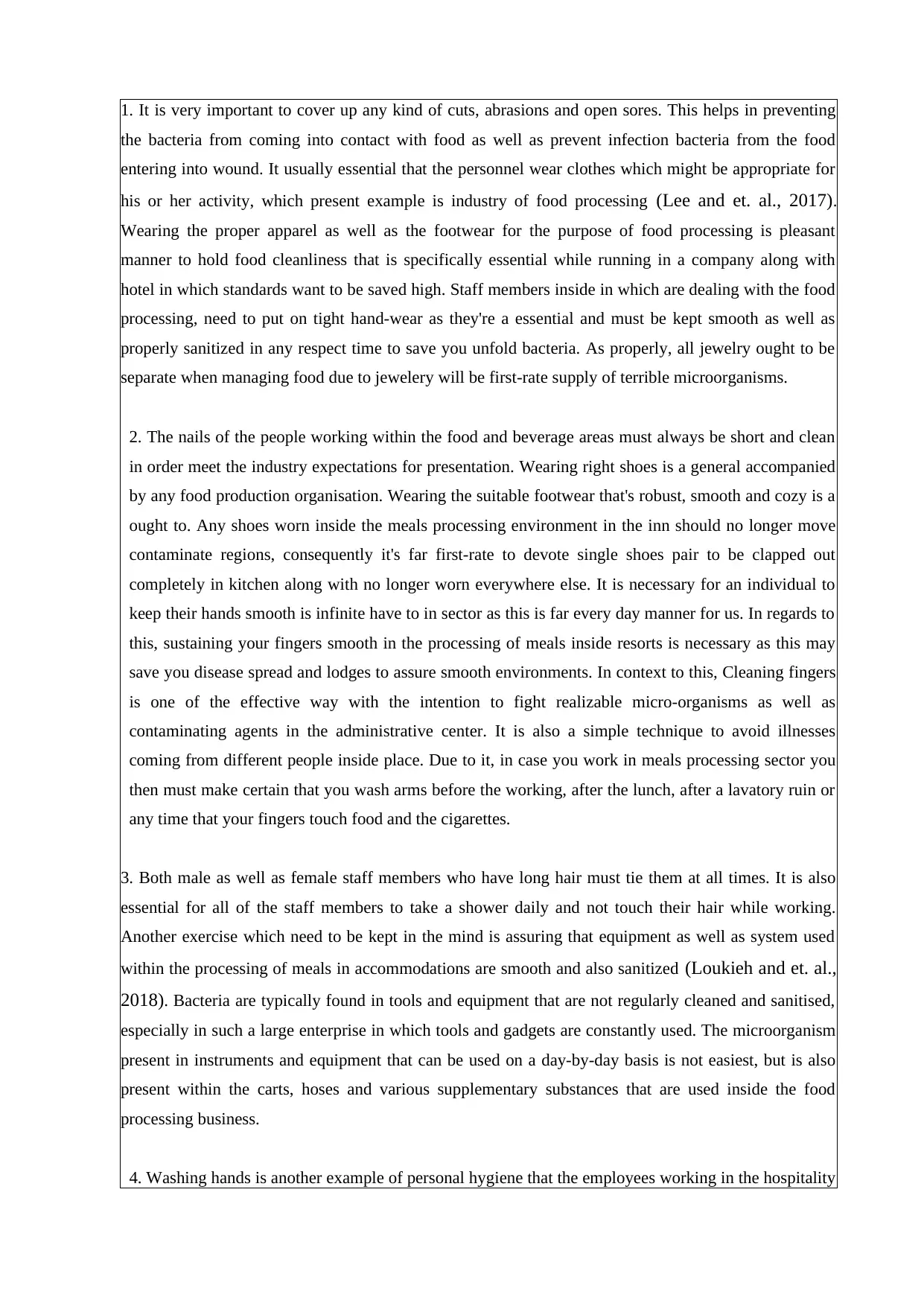
1. It is very important to cover up any kind of cuts, abrasions and open sores. This helps in preventing
the bacteria from coming into contact with food as well as prevent infection bacteria from the food
entering into wound. It usually essential that the personnel wear clothes which might be appropriate for
his or her activity, which present example is industry of food processing (Lee and et. al., 2017).
Wearing the proper apparel as well as the footwear for the purpose of food processing is pleasant
manner to hold food cleanliness that is specifically essential while running in a company along with
hotel in which standards want to be saved high. Staff members inside in which are dealing with the food
processing, need to put on tight hand-wear as they're a essential and must be kept smooth as well as
properly sanitized in any respect time to save you unfold bacteria. As properly, all jewelry ought to be
separate when managing food due to jewelery will be first-rate supply of terrible microorganisms.
2. The nails of the people working within the food and beverage areas must always be short and clean
in order meet the industry expectations for presentation. Wearing right shoes is a general accompanied
by any food production organisation. Wearing the suitable footwear that's robust, smooth and cozy is a
ought to. Any shoes worn inside the meals processing environment in the inn should no longer move
contaminate regions, consequently it's far first-rate to devote single shoes pair to be clapped out
completely in kitchen along with no longer worn everywhere else. It is necessary for an individual to
keep their hands smooth is infinite have to in sector as this is far every day manner for us. In regards to
this, sustaining your fingers smooth in the processing of meals inside resorts is necessary as this may
save you disease spread and lodges to assure smooth environments. In context to this, Cleaning fingers
is one of the effective way with the intention to fight realizable micro-organisms as well as
contaminating agents in the administrative center. It is also a simple technique to avoid illnesses
coming from different people inside place. Due to it, in case you work in meals processing sector you
then must make certain that you wash arms before the working, after the lunch, after a lavatory ruin or
any time that your fingers touch food and the cigarettes.
3. Both male as well as female staff members who have long hair must tie them at all times. It is also
essential for all of the staff members to take a shower daily and not touch their hair while working.
Another exercise which need to be kept in the mind is assuring that equipment as well as system used
within the processing of meals in accommodations are smooth and also sanitized (Loukieh and et. al.,
2018). Bacteria are typically found in tools and equipment that are not regularly cleaned and sanitised,
especially in such a large enterprise in which tools and gadgets are constantly used. The microorganism
present in instruments and equipment that can be used on a day-by-day basis is not easiest, but is also
present within the carts, hoses and various supplementary substances that are used inside the food
processing business.
4. Washing hands is another example of personal hygiene that the employees working in the hospitality
the bacteria from coming into contact with food as well as prevent infection bacteria from the food
entering into wound. It usually essential that the personnel wear clothes which might be appropriate for
his or her activity, which present example is industry of food processing (Lee and et. al., 2017).
Wearing the proper apparel as well as the footwear for the purpose of food processing is pleasant
manner to hold food cleanliness that is specifically essential while running in a company along with
hotel in which standards want to be saved high. Staff members inside in which are dealing with the food
processing, need to put on tight hand-wear as they're a essential and must be kept smooth as well as
properly sanitized in any respect time to save you unfold bacteria. As properly, all jewelry ought to be
separate when managing food due to jewelery will be first-rate supply of terrible microorganisms.
2. The nails of the people working within the food and beverage areas must always be short and clean
in order meet the industry expectations for presentation. Wearing right shoes is a general accompanied
by any food production organisation. Wearing the suitable footwear that's robust, smooth and cozy is a
ought to. Any shoes worn inside the meals processing environment in the inn should no longer move
contaminate regions, consequently it's far first-rate to devote single shoes pair to be clapped out
completely in kitchen along with no longer worn everywhere else. It is necessary for an individual to
keep their hands smooth is infinite have to in sector as this is far every day manner for us. In regards to
this, sustaining your fingers smooth in the processing of meals inside resorts is necessary as this may
save you disease spread and lodges to assure smooth environments. In context to this, Cleaning fingers
is one of the effective way with the intention to fight realizable micro-organisms as well as
contaminating agents in the administrative center. It is also a simple technique to avoid illnesses
coming from different people inside place. Due to it, in case you work in meals processing sector you
then must make certain that you wash arms before the working, after the lunch, after a lavatory ruin or
any time that your fingers touch food and the cigarettes.
3. Both male as well as female staff members who have long hair must tie them at all times. It is also
essential for all of the staff members to take a shower daily and not touch their hair while working.
Another exercise which need to be kept in the mind is assuring that equipment as well as system used
within the processing of meals in accommodations are smooth and also sanitized (Loukieh and et. al.,
2018). Bacteria are typically found in tools and equipment that are not regularly cleaned and sanitised,
especially in such a large enterprise in which tools and gadgets are constantly used. The microorganism
present in instruments and equipment that can be used on a day-by-day basis is not easiest, but is also
present within the carts, hoses and various supplementary substances that are used inside the food
processing business.
4. Washing hands is another example of personal hygiene that the employees working in the hospitality
Paraphrase This Document
Need a fresh take? Get an instant paraphrase of this document with our AI Paraphraser
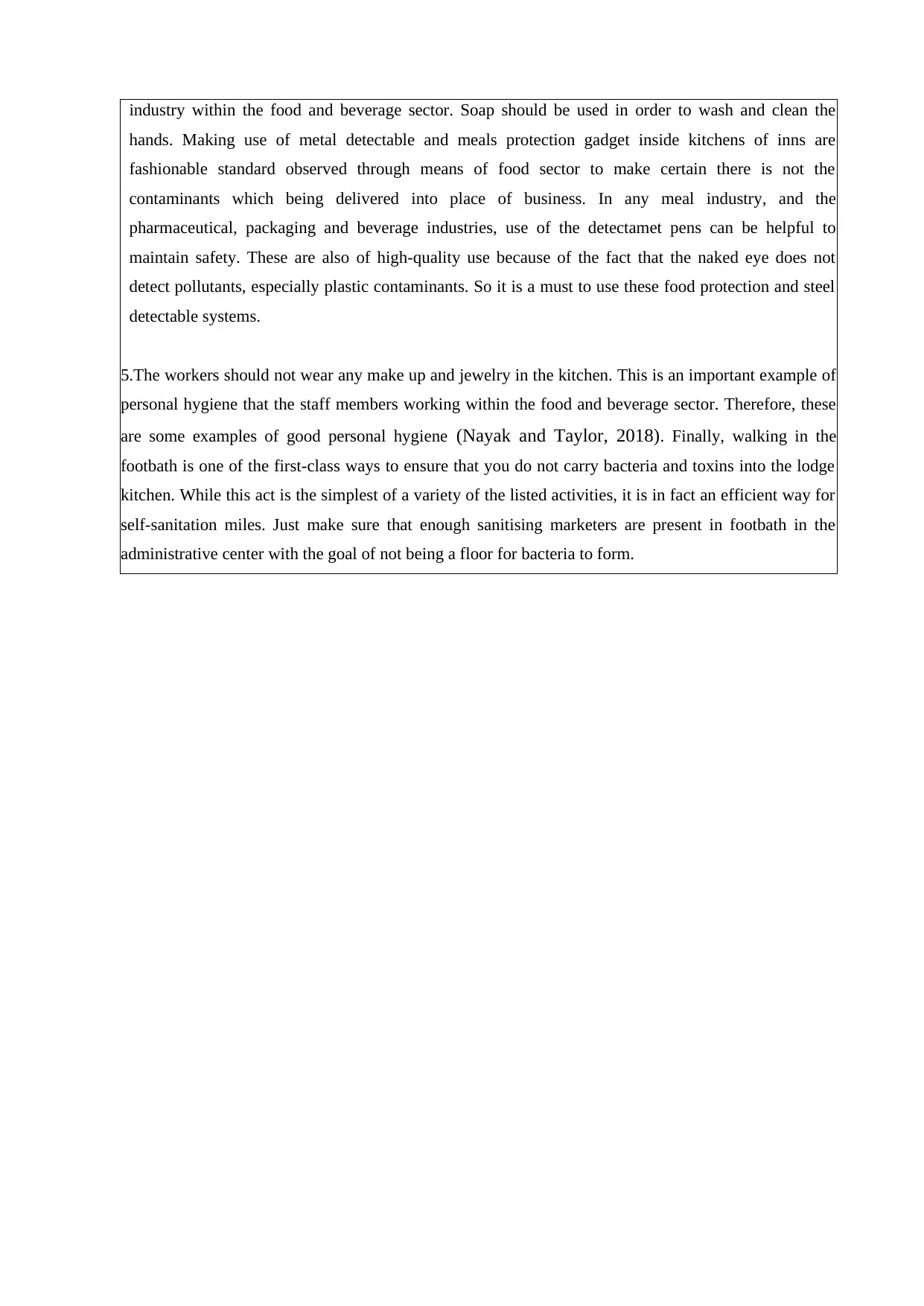
industry within the food and beverage sector. Soap should be used in order to wash and clean the
hands. Making use of metal detectable and meals protection gadget inside kitchens of inns are
fashionable standard observed through means of food sector to make certain there is not the
contaminants which being delivered into place of business. In any meal industry, and the
pharmaceutical, packaging and beverage industries, use of the detectamet pens can be helpful to
maintain safety. These are also of high-quality use because of the fact that the naked eye does not
detect pollutants, especially plastic contaminants. So it is a must to use these food protection and steel
detectable systems.
5.The workers should not wear any make up and jewelry in the kitchen. This is an important example of
personal hygiene that the staff members working within the food and beverage sector. Therefore, these
are some examples of good personal hygiene (Nayak and Taylor, 2018). Finally, walking in the
footbath is one of the first-class ways to ensure that you do not carry bacteria and toxins into the lodge
kitchen. While this act is the simplest of a variety of the listed activities, it is in fact an efficient way for
self-sanitation miles. Just make sure that enough sanitising marketers are present in footbath in the
administrative center with the goal of not being a floor for bacteria to form.
hands. Making use of metal detectable and meals protection gadget inside kitchens of inns are
fashionable standard observed through means of food sector to make certain there is not the
contaminants which being delivered into place of business. In any meal industry, and the
pharmaceutical, packaging and beverage industries, use of the detectamet pens can be helpful to
maintain safety. These are also of high-quality use because of the fact that the naked eye does not
detect pollutants, especially plastic contaminants. So it is a must to use these food protection and steel
detectable systems.
5.The workers should not wear any make up and jewelry in the kitchen. This is an important example of
personal hygiene that the staff members working within the food and beverage sector. Therefore, these
are some examples of good personal hygiene (Nayak and Taylor, 2018). Finally, walking in the
footbath is one of the first-class ways to ensure that you do not carry bacteria and toxins into the lodge
kitchen. While this act is the simplest of a variety of the listed activities, it is in fact an efficient way for
self-sanitation miles. Just make sure that enough sanitising marketers are present in footbath in the
administrative center with the goal of not being a floor for bacteria to form.
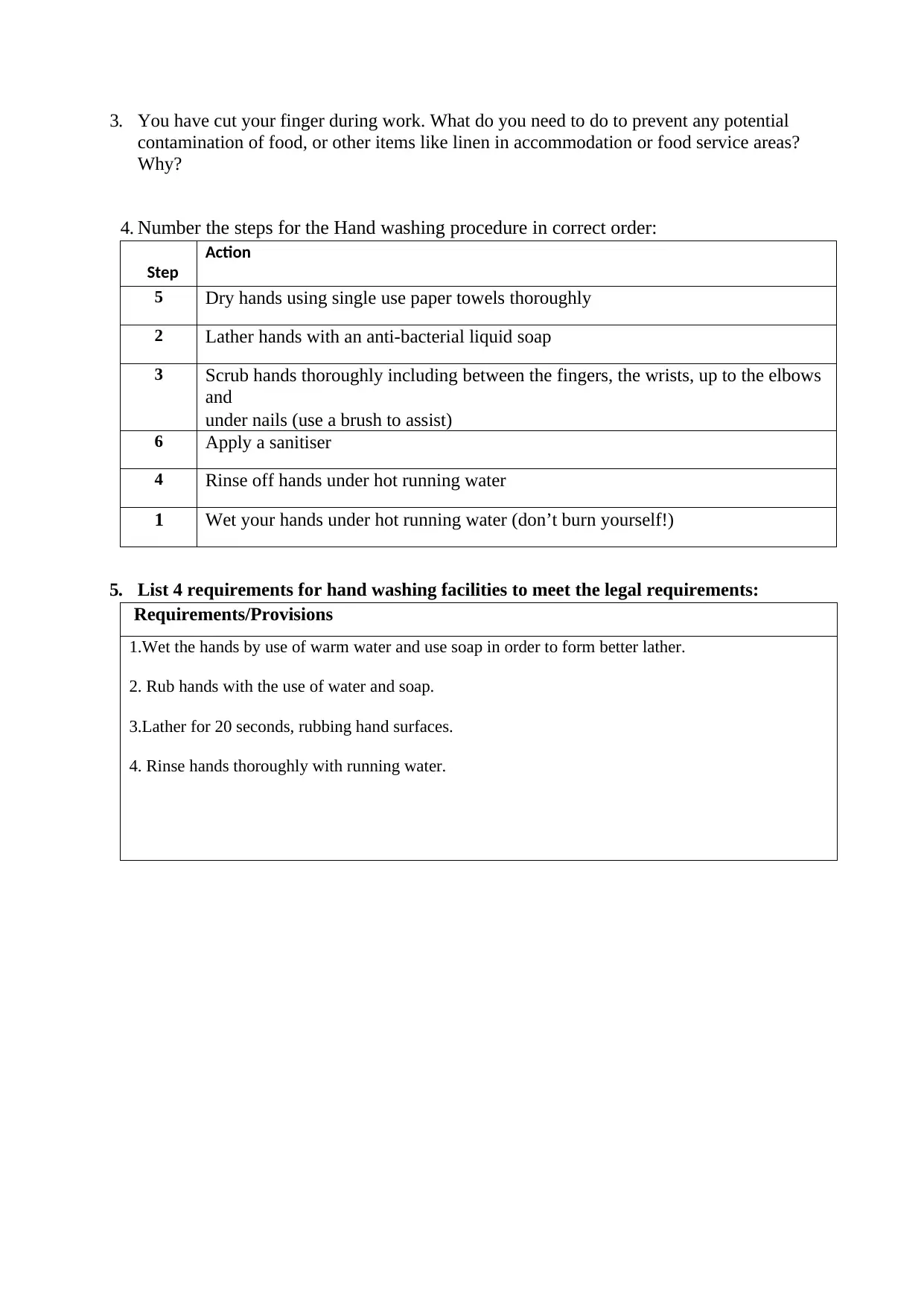
3. You have cut your finger during work. What do you need to do to prevent any potential
contamination of food, or other items like linen in accommodation or food service areas?
Why?
4. Number the steps for the Hand washing procedure in correct order:
Step
Action
5 Dry hands using single use paper towels thoroughly
2 Lather hands with an anti-bacterial liquid soap
3 Scrub hands thoroughly including between the fingers, the wrists, up to the elbows
and
under nails (use a brush to assist)
6 Apply a sanitiser
4 Rinse off hands under hot running water
1 Wet your hands under hot running water (don’t burn yourself!)
5. List 4 requirements for hand washing facilities to meet the legal requirements:
Requirements/Provisions
1.Wet the hands by use of warm water and use soap in order to form better lather.
2. Rub hands with the use of water and soap.
3.Lather for 20 seconds, rubbing hand surfaces.
4. Rinse hands thoroughly with running water.
contamination of food, or other items like linen in accommodation or food service areas?
Why?
4. Number the steps for the Hand washing procedure in correct order:
Step
Action
5 Dry hands using single use paper towels thoroughly
2 Lather hands with an anti-bacterial liquid soap
3 Scrub hands thoroughly including between the fingers, the wrists, up to the elbows
and
under nails (use a brush to assist)
6 Apply a sanitiser
4 Rinse off hands under hot running water
1 Wet your hands under hot running water (don’t burn yourself!)
5. List 4 requirements for hand washing facilities to meet the legal requirements:
Requirements/Provisions
1.Wet the hands by use of warm water and use soap in order to form better lather.
2. Rub hands with the use of water and soap.
3.Lather for 20 seconds, rubbing hand surfaces.
4. Rinse hands thoroughly with running water.
⊘ This is a preview!⊘
Do you want full access?
Subscribe today to unlock all pages.

Trusted by 1+ million students worldwide
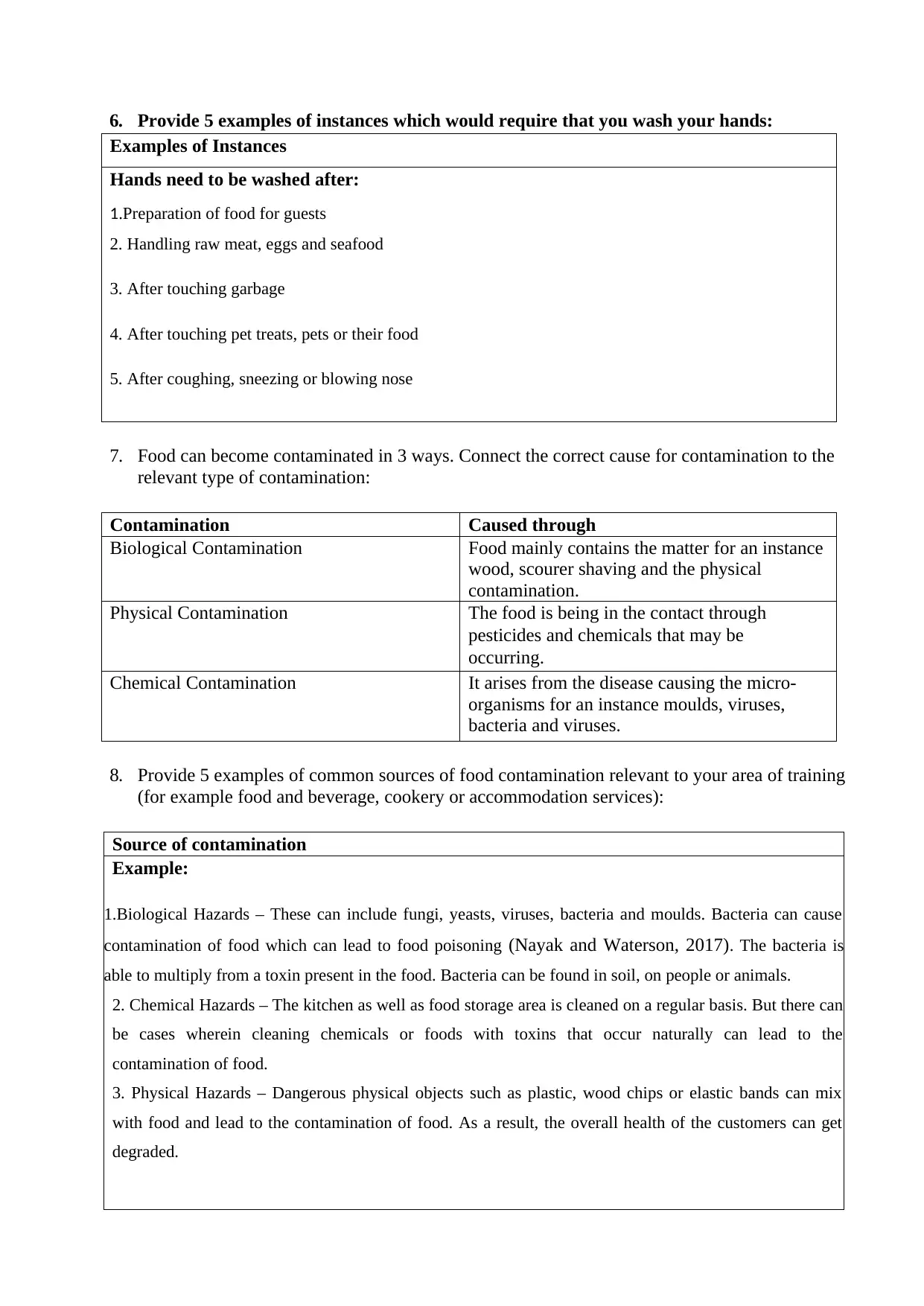
6. Provide 5 examples of instances which would require that you wash your hands:
Examples of Instances
Hands need to be washed after:
1.Preparation of food for guests
2. Handling raw meat, eggs and seafood
3. After touching garbage
4. After touching pet treats, pets or their food
5. After coughing, sneezing or blowing nose
7. Food can become contaminated in 3 ways. Connect the correct cause for contamination to the
relevant type of contamination:
Contamination Caused through
Biological Contamination Food mainly contains the matter for an instance
wood, scourer shaving and the physical
contamination.
Physical Contamination The food is being in the contact through
pesticides and chemicals that may be
occurring.
Chemical Contamination It arises from the disease causing the micro-
organisms for an instance moulds, viruses,
bacteria and viruses.
8. Provide 5 examples of common sources of food contamination relevant to your area of training
(for example food and beverage, cookery or accommodation services):
Source of contamination
Example:
1.Biological Hazards – These can include fungi, yeasts, viruses, bacteria and moulds. Bacteria can cause
contamination of food which can lead to food poisoning (Nayak and Waterson, 2017). The bacteria is
able to multiply from a toxin present in the food. Bacteria can be found in soil, on people or animals.
2. Chemical Hazards – The kitchen as well as food storage area is cleaned on a regular basis. But there can
be cases wherein cleaning chemicals or foods with toxins that occur naturally can lead to the
contamination of food.
3. Physical Hazards – Dangerous physical objects such as plastic, wood chips or elastic bands can mix
with food and lead to the contamination of food. As a result, the overall health of the customers can get
degraded.
Examples of Instances
Hands need to be washed after:
1.Preparation of food for guests
2. Handling raw meat, eggs and seafood
3. After touching garbage
4. After touching pet treats, pets or their food
5. After coughing, sneezing or blowing nose
7. Food can become contaminated in 3 ways. Connect the correct cause for contamination to the
relevant type of contamination:
Contamination Caused through
Biological Contamination Food mainly contains the matter for an instance
wood, scourer shaving and the physical
contamination.
Physical Contamination The food is being in the contact through
pesticides and chemicals that may be
occurring.
Chemical Contamination It arises from the disease causing the micro-
organisms for an instance moulds, viruses,
bacteria and viruses.
8. Provide 5 examples of common sources of food contamination relevant to your area of training
(for example food and beverage, cookery or accommodation services):
Source of contamination
Example:
1.Biological Hazards – These can include fungi, yeasts, viruses, bacteria and moulds. Bacteria can cause
contamination of food which can lead to food poisoning (Nayak and Waterson, 2017). The bacteria is
able to multiply from a toxin present in the food. Bacteria can be found in soil, on people or animals.
2. Chemical Hazards – The kitchen as well as food storage area is cleaned on a regular basis. But there can
be cases wherein cleaning chemicals or foods with toxins that occur naturally can lead to the
contamination of food.
3. Physical Hazards – Dangerous physical objects such as plastic, wood chips or elastic bands can mix
with food and lead to the contamination of food. As a result, the overall health of the customers can get
degraded.
Paraphrase This Document
Need a fresh take? Get an instant paraphrase of this document with our AI Paraphraser
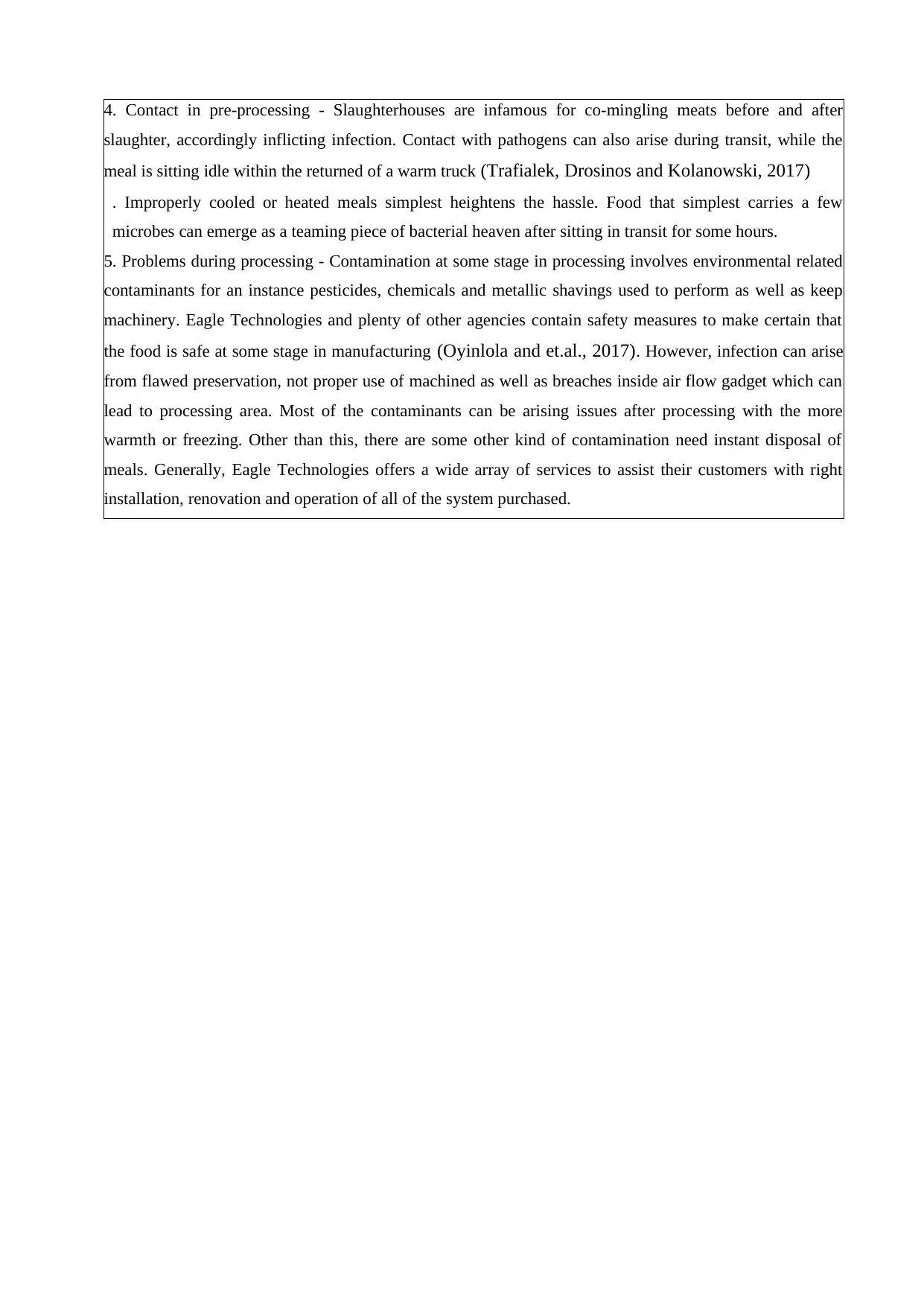
4. Contact in pre-processing - Slaughterhouses are infamous for co-mingling meats before and after
slaughter, accordingly inflicting infection. Contact with pathogens can also arise during transit, while the
meal is sitting idle within the returned of a warm truck (Trafialek, Drosinos and Kolanowski, 2017)
. Improperly cooled or heated meals simplest heightens the hassle. Food that simplest carries a few
microbes can emerge as a teaming piece of bacterial heaven after sitting in transit for some hours.
5. Problems during processing - Contamination at some stage in processing involves environmental related
contaminants for an instance pesticides, chemicals and metallic shavings used to perform as well as keep
machinery. Eagle Technologies and plenty of other agencies contain safety measures to make certain that
the food is safe at some stage in manufacturing (Oyinlola and et.al., 2017). However, infection can arise
from flawed preservation, not proper use of machined as well as breaches inside air flow gadget which can
lead to processing area. Most of the contaminants can be arising issues after processing with the more
warmth or freezing. Other than this, there are some other kind of contamination need instant disposal of
meals. Generally, Eagle Technologies offers a wide array of services to assist their customers with right
installation, renovation and operation of all of the system purchased.
slaughter, accordingly inflicting infection. Contact with pathogens can also arise during transit, while the
meal is sitting idle within the returned of a warm truck (Trafialek, Drosinos and Kolanowski, 2017)
. Improperly cooled or heated meals simplest heightens the hassle. Food that simplest carries a few
microbes can emerge as a teaming piece of bacterial heaven after sitting in transit for some hours.
5. Problems during processing - Contamination at some stage in processing involves environmental related
contaminants for an instance pesticides, chemicals and metallic shavings used to perform as well as keep
machinery. Eagle Technologies and plenty of other agencies contain safety measures to make certain that
the food is safe at some stage in manufacturing (Oyinlola and et.al., 2017). However, infection can arise
from flawed preservation, not proper use of machined as well as breaches inside air flow gadget which can
lead to processing area. Most of the contaminants can be arising issues after processing with the more
warmth or freezing. Other than this, there are some other kind of contamination need instant disposal of
meals. Generally, Eagle Technologies offers a wide array of services to assist their customers with right
installation, renovation and operation of all of the system purchased.
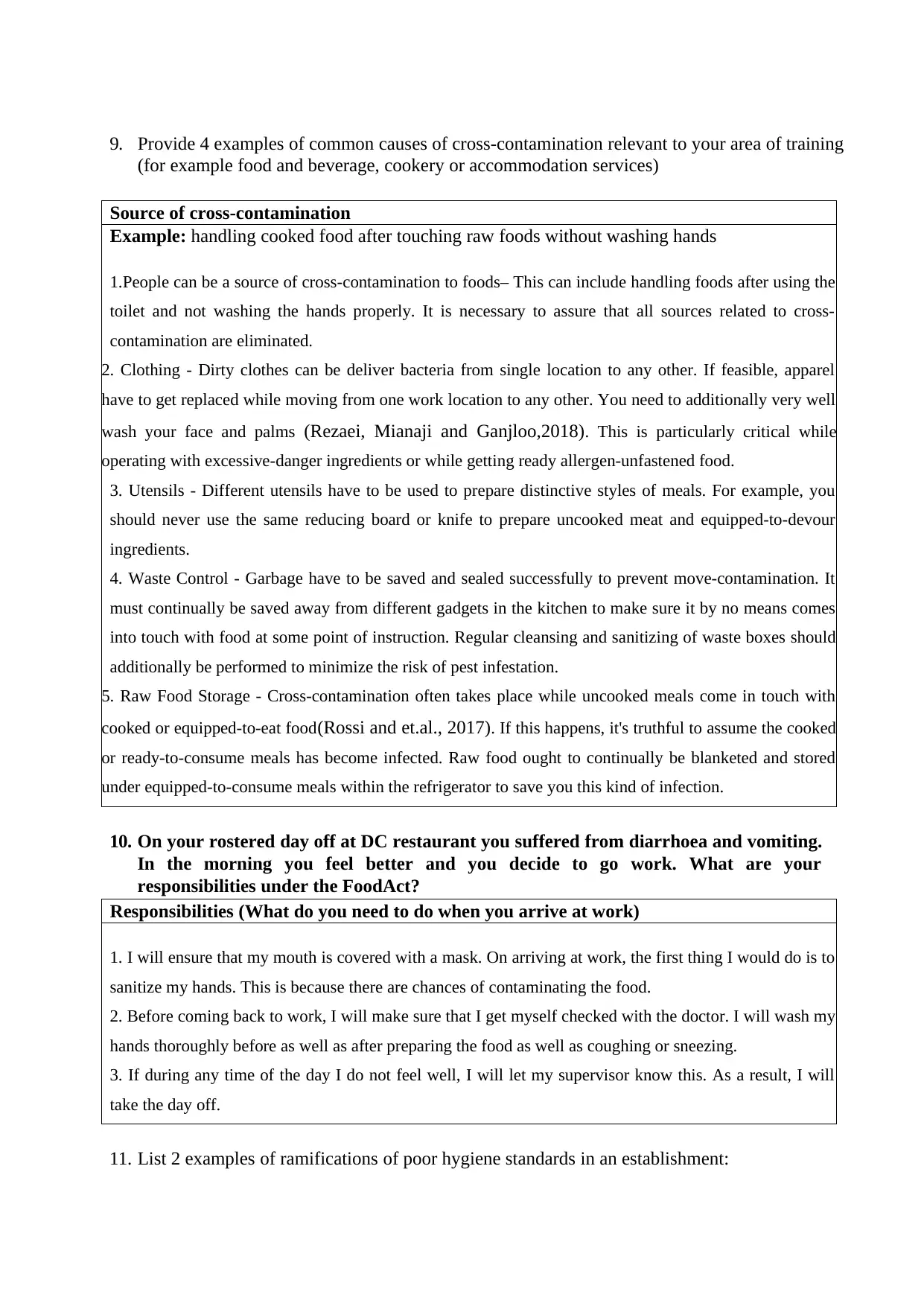
9. Provide 4 examples of common causes of cross-contamination relevant to your area of training
(for example food and beverage, cookery or accommodation services)
Source of cross-contamination
Example: handling cooked food after touching raw foods without washing hands
1.People can be a source of cross-contamination to foods– This can include handling foods after using the
toilet and not washing the hands properly. It is necessary to assure that all sources related to cross-
contamination are eliminated.
2. Clothing - Dirty clothes can be deliver bacteria from single location to any other. If feasible, apparel
have to get replaced while moving from one work location to any other. You need to additionally very well
wash your face and palms (Rezaei, Mianaji and Ganjloo,2018). This is particularly critical while
operating with excessive-danger ingredients or while getting ready allergen-unfastened food.
3. Utensils - Different utensils have to be used to prepare distinctive styles of meals. For example, you
should never use the same reducing board or knife to prepare uncooked meat and equipped-to-devour
ingredients.
4. Waste Control - Garbage have to be saved and sealed successfully to prevent move-contamination. It
must continually be saved away from different gadgets in the kitchen to make sure it by no means comes
into touch with food at some point of instruction. Regular cleansing and sanitizing of waste boxes should
additionally be performed to minimize the risk of pest infestation.
5. Raw Food Storage - Cross-contamination often takes place while uncooked meals come in touch with
cooked or equipped-to-eat food(Rossi and et.al., 2017). If this happens, it's truthful to assume the cooked
or ready-to-consume meals has become infected. Raw food ought to continually be blanketed and stored
under equipped-to-consume meals within the refrigerator to save you this kind of infection.
10. On your rostered day off at DC restaurant you suffered from diarrhoea and vomiting.
In the morning you feel better and you decide to go work. What are your
responsibilities under the FoodAct?
Responsibilities (What do you need to do when you arrive at work)
1. I will ensure that my mouth is covered with a mask. On arriving at work, the first thing I would do is to
sanitize my hands. This is because there are chances of contaminating the food.
2. Before coming back to work, I will make sure that I get myself checked with the doctor. I will wash my
hands thoroughly before as well as after preparing the food as well as coughing or sneezing.
3. If during any time of the day I do not feel well, I will let my supervisor know this. As a result, I will
take the day off.
11. List 2 examples of ramifications of poor hygiene standards in an establishment:
(for example food and beverage, cookery or accommodation services)
Source of cross-contamination
Example: handling cooked food after touching raw foods without washing hands
1.People can be a source of cross-contamination to foods– This can include handling foods after using the
toilet and not washing the hands properly. It is necessary to assure that all sources related to cross-
contamination are eliminated.
2. Clothing - Dirty clothes can be deliver bacteria from single location to any other. If feasible, apparel
have to get replaced while moving from one work location to any other. You need to additionally very well
wash your face and palms (Rezaei, Mianaji and Ganjloo,2018). This is particularly critical while
operating with excessive-danger ingredients or while getting ready allergen-unfastened food.
3. Utensils - Different utensils have to be used to prepare distinctive styles of meals. For example, you
should never use the same reducing board or knife to prepare uncooked meat and equipped-to-devour
ingredients.
4. Waste Control - Garbage have to be saved and sealed successfully to prevent move-contamination. It
must continually be saved away from different gadgets in the kitchen to make sure it by no means comes
into touch with food at some point of instruction. Regular cleansing and sanitizing of waste boxes should
additionally be performed to minimize the risk of pest infestation.
5. Raw Food Storage - Cross-contamination often takes place while uncooked meals come in touch with
cooked or equipped-to-eat food(Rossi and et.al., 2017). If this happens, it's truthful to assume the cooked
or ready-to-consume meals has become infected. Raw food ought to continually be blanketed and stored
under equipped-to-consume meals within the refrigerator to save you this kind of infection.
10. On your rostered day off at DC restaurant you suffered from diarrhoea and vomiting.
In the morning you feel better and you decide to go work. What are your
responsibilities under the FoodAct?
Responsibilities (What do you need to do when you arrive at work)
1. I will ensure that my mouth is covered with a mask. On arriving at work, the first thing I would do is to
sanitize my hands. This is because there are chances of contaminating the food.
2. Before coming back to work, I will make sure that I get myself checked with the doctor. I will wash my
hands thoroughly before as well as after preparing the food as well as coughing or sneezing.
3. If during any time of the day I do not feel well, I will let my supervisor know this. As a result, I will
take the day off.
11. List 2 examples of ramifications of poor hygiene standards in an establishment:
⊘ This is a preview!⊘
Do you want full access?
Subscribe today to unlock all pages.

Trusted by 1+ million students worldwide
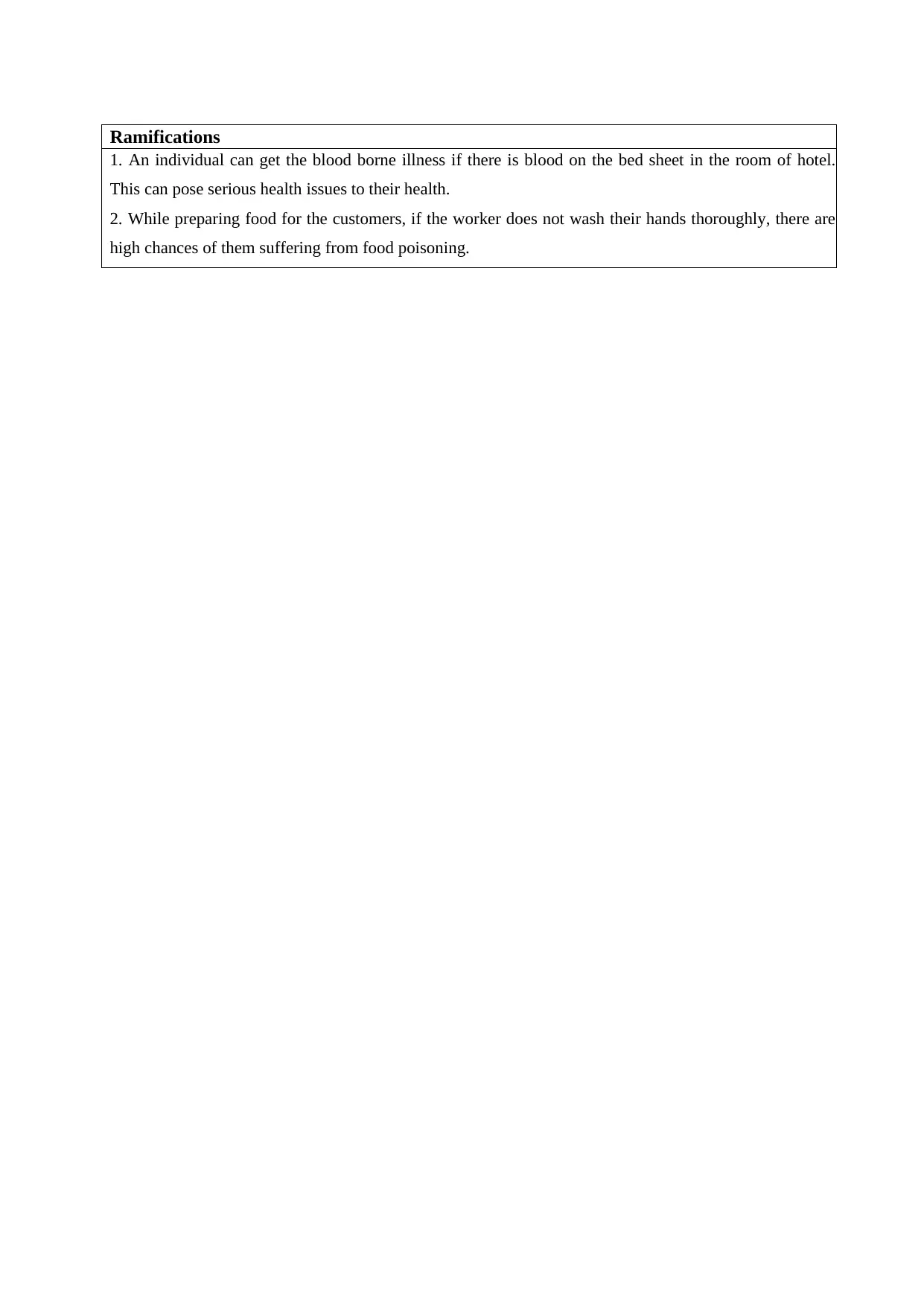
Ramifications
1. An individual can get the blood borne illness if there is blood on the bed sheet in the room of hotel.
This can pose serious health issues to their health.
2. While preparing food for the customers, if the worker does not wash their hands thoroughly, there are
high chances of them suffering from food poisoning.
1. An individual can get the blood borne illness if there is blood on the bed sheet in the room of hotel.
This can pose serious health issues to their health.
2. While preparing food for the customers, if the worker does not wash their hands thoroughly, there are
high chances of them suffering from food poisoning.
Paraphrase This Document
Need a fresh take? Get an instant paraphrase of this document with our AI Paraphraser
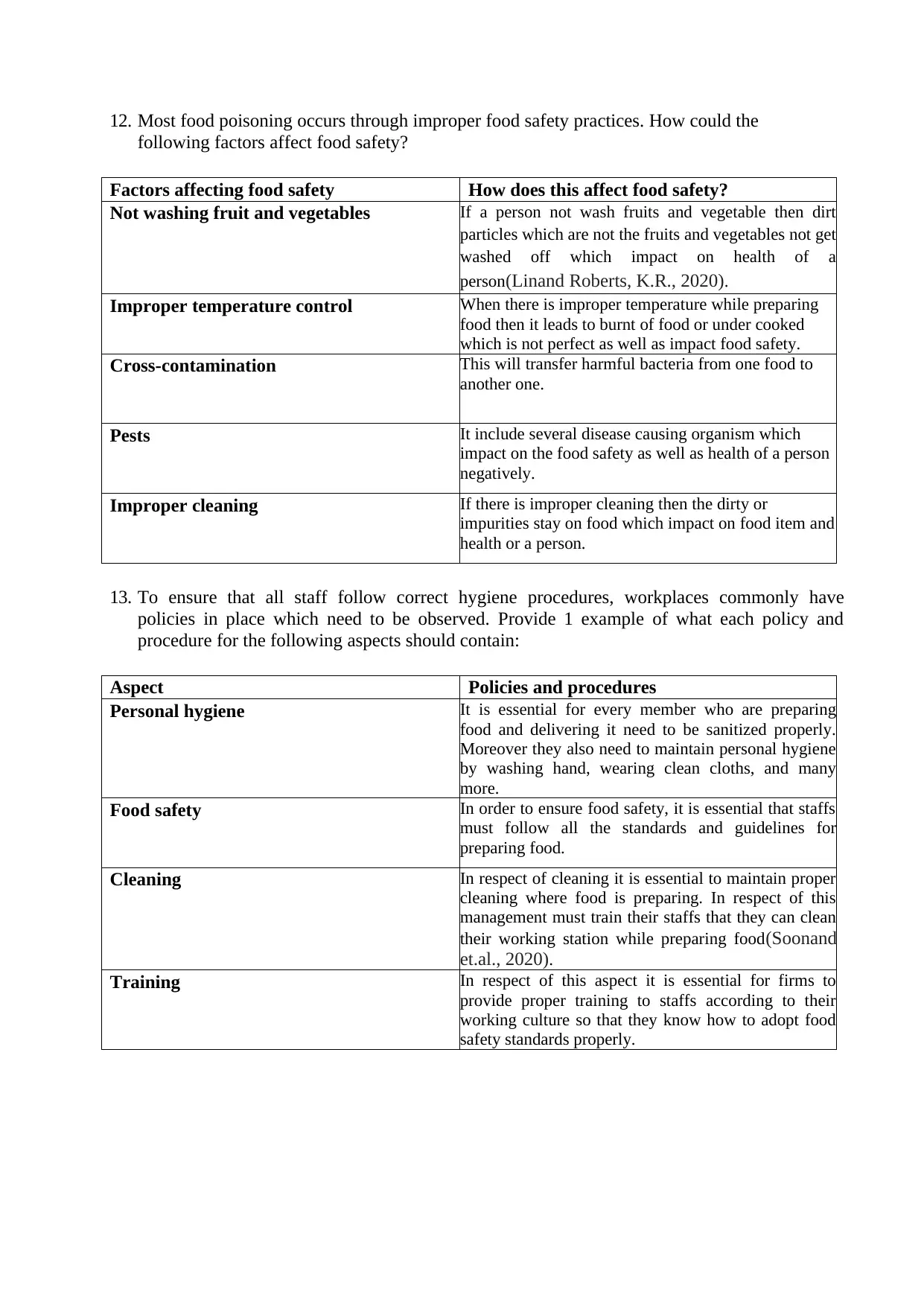
12. Most food poisoning occurs through improper food safety practices. How could the
following factors affect food safety?
Factors affecting food safety How does this affect food safety?
Not washing fruit and vegetables If a person not wash fruits and vegetable then dirt
particles which are not the fruits and vegetables not get
washed off which impact on health of a
person(Linand Roberts, K.R., 2020).
Improper temperature control When there is improper temperature while preparing
food then it leads to burnt of food or under cooked
which is not perfect as well as impact food safety.
Cross-contamination This will transfer harmful bacteria from one food to
another one.
Pests It include several disease causing organism which
impact on the food safety as well as health of a person
negatively.
Improper cleaning If there is improper cleaning then the dirty or
impurities stay on food which impact on food item and
health or a person.
13. To ensure that all staff follow correct hygiene procedures, workplaces commonly have
policies in place which need to be observed. Provide 1 example of what each policy and
procedure for the following aspects should contain:
Aspect Policies and procedures
Personal hygiene It is essential for every member who are preparing
food and delivering it need to be sanitized properly.
Moreover they also need to maintain personal hygiene
by washing hand, wearing clean cloths, and many
more.
Food safety In order to ensure food safety, it is essential that staffs
must follow all the standards and guidelines for
preparing food.
Cleaning In respect of cleaning it is essential to maintain proper
cleaning where food is preparing. In respect of this
management must train their staffs that they can clean
their working station while preparing food(Soonand
et.al., 2020).
Training In respect of this aspect it is essential for firms to
provide proper training to staffs according to their
working culture so that they know how to adopt food
safety standards properly.
following factors affect food safety?
Factors affecting food safety How does this affect food safety?
Not washing fruit and vegetables If a person not wash fruits and vegetable then dirt
particles which are not the fruits and vegetables not get
washed off which impact on health of a
person(Linand Roberts, K.R., 2020).
Improper temperature control When there is improper temperature while preparing
food then it leads to burnt of food or under cooked
which is not perfect as well as impact food safety.
Cross-contamination This will transfer harmful bacteria from one food to
another one.
Pests It include several disease causing organism which
impact on the food safety as well as health of a person
negatively.
Improper cleaning If there is improper cleaning then the dirty or
impurities stay on food which impact on food item and
health or a person.
13. To ensure that all staff follow correct hygiene procedures, workplaces commonly have
policies in place which need to be observed. Provide 1 example of what each policy and
procedure for the following aspects should contain:
Aspect Policies and procedures
Personal hygiene It is essential for every member who are preparing
food and delivering it need to be sanitized properly.
Moreover they also need to maintain personal hygiene
by washing hand, wearing clean cloths, and many
more.
Food safety In order to ensure food safety, it is essential that staffs
must follow all the standards and guidelines for
preparing food.
Cleaning In respect of cleaning it is essential to maintain proper
cleaning where food is preparing. In respect of this
management must train their staffs that they can clean
their working station while preparing food(Soonand
et.al., 2020).
Training In respect of this aspect it is essential for firms to
provide proper training to staffs according to their
working culture so that they know how to adopt food
safety standards properly.
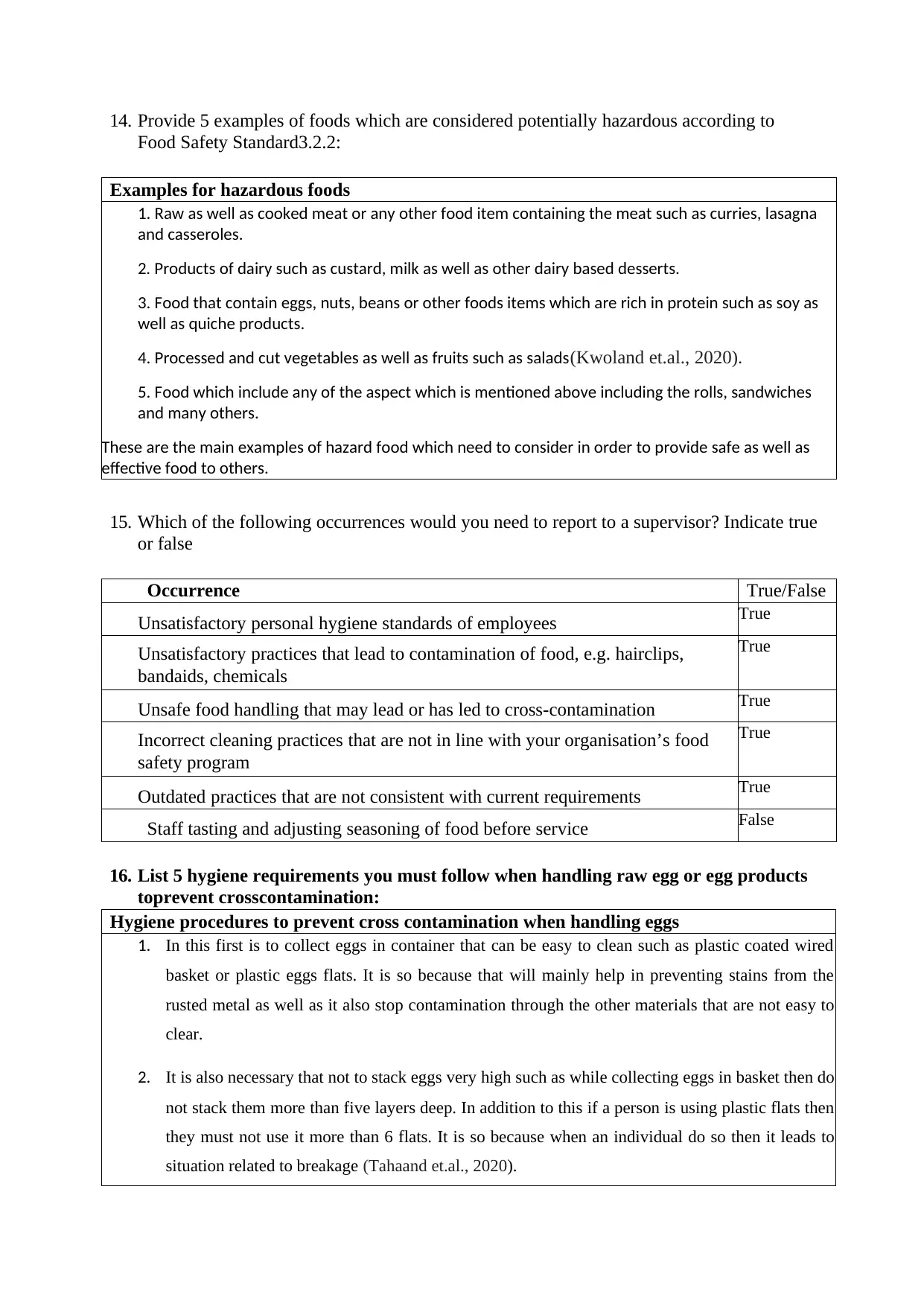
14. Provide 5 examples of foods which are considered potentially hazardous according to
Food Safety Standard3.2.2:
Examples for hazardous foods
1. Raw as well as cooked meat or any other food item containing the meat such as curries, lasagna
and casseroles.
2. Products of dairy such as custard, milk as well as other dairy based desserts.
3. Food that contain eggs, nuts, beans or other foods items which are rich in protein such as soy as
well as quiche products.
4. Processed and cut vegetables as well as fruits such as salads(Kwoland et.al., 2020).
5. Food which include any of the aspect which is mentioned above including the rolls, sandwiches
and many others.
These are the main examples of hazard food which need to consider in order to provide safe as well as
effective food to others.
15. Which of the following occurrences would you need to report to a supervisor? Indicate true
or false
Occurrence True/False
Unsatisfactory personal hygiene standards of employees True
Unsatisfactory practices that lead to contamination of food, e.g. hairclips,
bandaids, chemicals
True
Unsafe food handling that may lead or has led to cross-contamination True
Incorrect cleaning practices that are not in line with your organisation’s food
safety program
True
Outdated practices that are not consistent with current requirements True
Staff tasting and adjusting seasoning of food before service False
16. List 5 hygiene requirements you must follow when handling raw egg or egg products
toprevent crosscontamination:
Hygiene procedures to prevent cross contamination when handling eggs
1. In this first is to collect eggs in container that can be easy to clean such as plastic coated wired
basket or plastic eggs flats. It is so because that will mainly help in preventing stains from the
rusted metal as well as it also stop contamination through the other materials that are not easy to
clear.
2. It is also necessary that not to stack eggs very high such as while collecting eggs in basket then do
not stack them more than five layers deep. In addition to this if a person is using plastic flats then
they must not use it more than 6 flats. It is so because when an individual do so then it leads to
situation related to breakage (Tahaand et.al., 2020).
Food Safety Standard3.2.2:
Examples for hazardous foods
1. Raw as well as cooked meat or any other food item containing the meat such as curries, lasagna
and casseroles.
2. Products of dairy such as custard, milk as well as other dairy based desserts.
3. Food that contain eggs, nuts, beans or other foods items which are rich in protein such as soy as
well as quiche products.
4. Processed and cut vegetables as well as fruits such as salads(Kwoland et.al., 2020).
5. Food which include any of the aspect which is mentioned above including the rolls, sandwiches
and many others.
These are the main examples of hazard food which need to consider in order to provide safe as well as
effective food to others.
15. Which of the following occurrences would you need to report to a supervisor? Indicate true
or false
Occurrence True/False
Unsatisfactory personal hygiene standards of employees True
Unsatisfactory practices that lead to contamination of food, e.g. hairclips,
bandaids, chemicals
True
Unsafe food handling that may lead or has led to cross-contamination True
Incorrect cleaning practices that are not in line with your organisation’s food
safety program
True
Outdated practices that are not consistent with current requirements True
Staff tasting and adjusting seasoning of food before service False
16. List 5 hygiene requirements you must follow when handling raw egg or egg products
toprevent crosscontamination:
Hygiene procedures to prevent cross contamination when handling eggs
1. In this first is to collect eggs in container that can be easy to clean such as plastic coated wired
basket or plastic eggs flats. It is so because that will mainly help in preventing stains from the
rusted metal as well as it also stop contamination through the other materials that are not easy to
clear.
2. It is also necessary that not to stack eggs very high such as while collecting eggs in basket then do
not stack them more than five layers deep. In addition to this if a person is using plastic flats then
they must not use it more than 6 flats. It is so because when an individual do so then it leads to
situation related to breakage (Tahaand et.al., 2020).
⊘ This is a preview!⊘
Do you want full access?
Subscribe today to unlock all pages.

Trusted by 1+ million students worldwide
1 out of 17
Related Documents
Your All-in-One AI-Powered Toolkit for Academic Success.
+13062052269
info@desklib.com
Available 24*7 on WhatsApp / Email
![[object Object]](/_next/static/media/star-bottom.7253800d.svg)
Unlock your academic potential
Copyright © 2020–2025 A2Z Services. All Rights Reserved. Developed and managed by ZUCOL.




